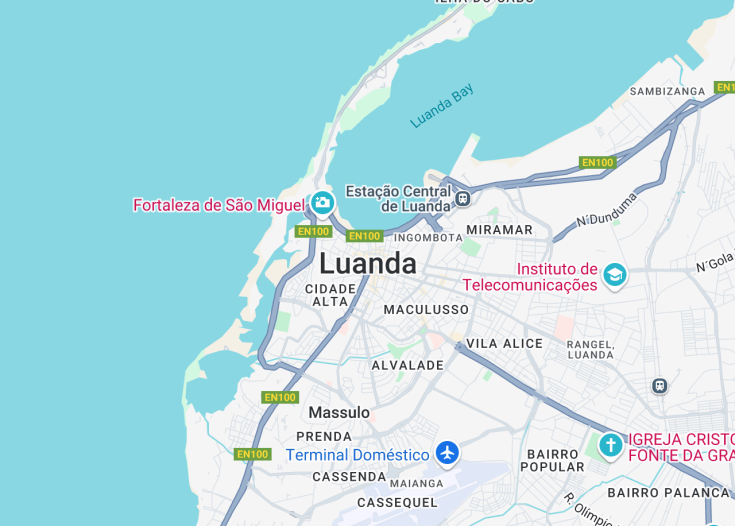Luanda, the bustling capital of Angola, stands as a vibrant gateway to this African nation’s rich cultural tapestry and stunning natural landscapes. This city uniquely blends traditional Portuguese influences with modern dynamics, making it a compelling destination for travelers.
From the charming colonial architecture of the Cidade Alta to the lively markets such as Mercado do Kinaxixi, Luanda offers a diverse spectrum of experiences. The city’s coastal location further provides picturesque beaches like Ilha do Cabo, which are perfect for relaxation and water activities.
Ensure to visit the Fortaleza de São Miguel for a stunning view of Luanda Bay and to soak in the history of Angola’s colonial past.
Try sampling local Angolan cuisine, particularly the fish dishes like ‘mufete’, at the bustling eateries along the Bay of Luanda.
Top things to do & see in Luanda
Select the following sights and activities to discover best tickets and tours available in Luanda.
Luanda: A Vibrant Heart of Angola
| Country | Angola |
| Time in Luanda | GMT+1 |
| Language spoken | Portuguese |
| Population | 8.3 million (2023 estimate) |
| Currency | Angolan Kwanza (Kz, AOA) |
| Airports |
|
Luanda, the capital city of Angola, is a hub of economic and cultural activity. Situated on Angola’s coastline, it provides picturesque ocean views contrasted by the bustling urban environment.
With a history that stretches back to its founding by the Portuguese in 1575, Luanda has evolved into a vibrant metropolis that plays a crucial role in Angola’s oil-driven economy. The city’s infrastructure reflects its colonial past and its modernist aspirations, making it a unique blend of old and new.
Where is Luanda?
Luanda is located in the northwestern part of Angola, along the Atlantic coast.
Distances:
| Route | Distance by car | Time by car |
|---|---|---|
| Lobito to Luanda | 314 miles (505 km) | ~6 hours |
| Cabinda to Luanda | 295 miles (475 km) | ~50 minutes by plane (no direct road route) |
| Benguela to Luanda | 360 miles (580 km) | ~7 hours 30 minutes</nor |
What is Luanda famous for?
Luanda is renowned for its rich history, vibrant culture, and as a primary center for Angola’s booming oil industry. The city is also home to some of Africa’s most magnificent colonial architecture and bustling markets.
History
Before 1575: Early Inhabitants
The area now known as Luanda was originally inhabited by indigenous African groups, primarily the Akan people. Prior to European arrival, these groups engaged in fishing, agriculture, and trading with neighboring tribes. The natural harbor facilitated local commerce and was a pivotal point for intra-continental trade routes.
1575-1700: Foundation and Colonial Era
Luanda was established by the Portuguese explorer Paulo Dias de Novais on January 25, 1575. It was named São Paulo da Assunção de Loanda and served as a vital center for slave trade to Brazil and Cuba. The city developed as a Portuguese settlement with the construction of churches, residential buildings, and fortresses, predominantly around the port area.
1700-1975: Expansion and Conflicts
Throughout the 18th and 19th centuries, Luanda experienced significant expansion both economically and physically. The city became the administrative center of Portuguese Angola. However, this period was marred by internal conflicts, slave trade resistance, and increasing demands for local governance, leading to frequent uprisings against colonial rule.
1975-Present: Independence and Modern Development
Following a protracted struggle, Angola gained independence from Portugal on November 11, 1975, with Luanda becoming the nation’s capital. The subsequent civil war heavily damaged the city, but post-war reconstruction has led to rapid modernization. Today, Luanda is a bustling metropolis showcasing a blend of historic Portuguese architecture and gleaming new skyscrapers, reflecting its role as one of the most important economic centers in Africa.
Visit Luanda
What to see and do in Luanda
Luanda, the capital city of Angola, offers a variety of attractions and activities for visitors. Explore the historic Fortaleza de São Miguel, originally built in 1576 to defend the city. The fortress provides panoramic views of Luanda Bay and houses the Museum of the Armed Forces.
The city’s coastline, such as the Ilha do Cabo, a lively area filled with restaurants and bars, is perfect for relaxation and enjoying fresh seafood. Additionally, do not miss the National Museum of Slavery (Museu Nacional da Escravatura) to gain insight into the harsh realities of the transatlantic slave trade. For shopping and local culture, visit the bustling Benfica Market where you can find traditional Angolan artifacts and textiles.
Festivals and Events in Luanda
Luanda hosts various cultural and music festivals throughout the year that reflect its rich heritage and vibrant contemporary scene. Key events include the Luanda Jazz Festival, which typically occurs in July and features local and international artists.
The Carnival of Luanda, held in February, is another major event where locals participate in parades dressed in bright, elaborate costumes, showcasing Angolan music and dance traditions.
Best time to visit Luanda
The best time to visit Luanda is between May and October during the dry season when the weather is most pleasant, with lower humidity and cooler temperatures. This period offers ideal conditions for exploring the city and enjoying outdoor activities without the heavy rainfall that characterizes other months.
Is Luanda worth visiting?
Luanda offers a compelling mix of historical significance and modern development, making it a unique destination in Africa. While it boasts beautiful coastal views, rich cultural experiences, and historical sites, it is also known for its high cost of living and traffic congestion.
Visitors should be prepared for these challenges. However, for those interested in exploring a dynamic city that embodies the complexities and resilience of history and modernity, Luanda is undoubtedly worth visiting.










